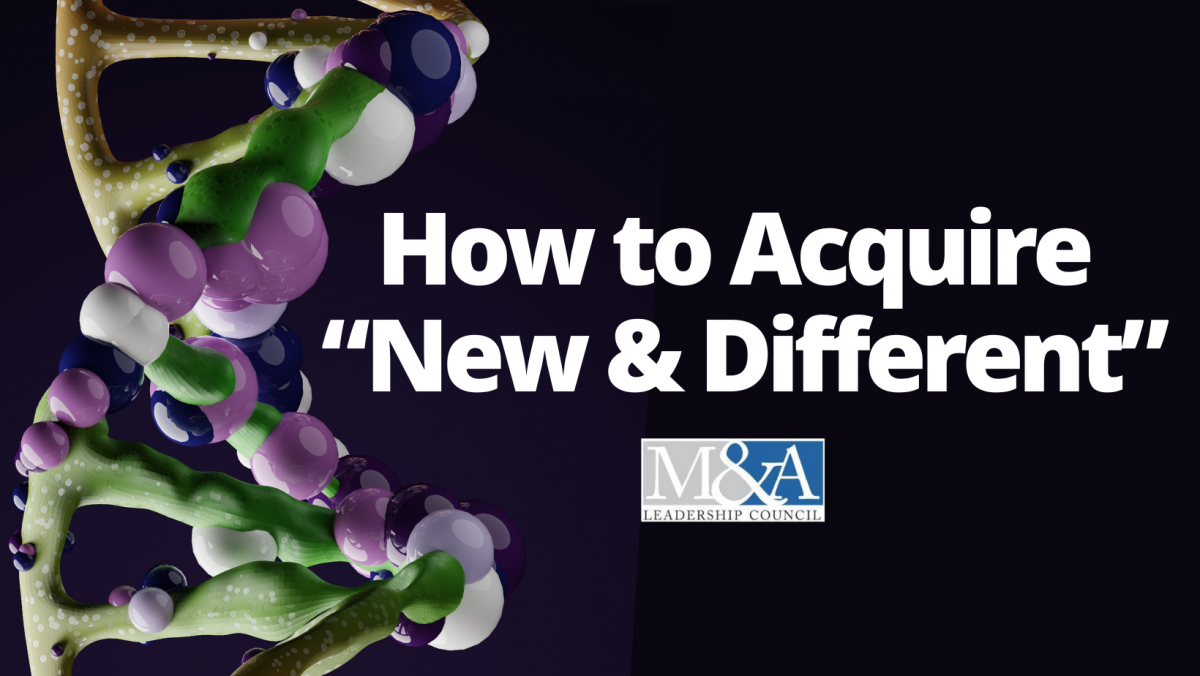SaaS Executives Share 5 Lessons
By John Christman, Former Corporate Development Global Head of M&A Integration, Cognizant Technology Solutions
Digital transformation is increasingly driving the acquisition of new, different and non-traditional businesses that require a substantially different approach to integration. And even though these acquisitions have become a strategy of choice for organizations in all sectors, our knowledge of best practices for “acquiring different” is extremely limited. Indeed, what we know consists mostly of “lessons learned,” and these tend to focus on the front end of deals, in targeting, valuation and due diligence—not on integration.
To address this gap, our colleagues at M&A Partners conducted a survey of software industry professionals who were experienced at acquisitions and at being acquired. The survey objective was to identify, document, and adapt best practices and key lessons learned for the following:
- Managing, scaling and integrating substantially “different” acquisitions
- Determining the optimal integration strategy
- Aligning dramatically different cultures
- Transitioning from short-term operational integration to long-term value creation
Although the survey was mostly focused on SaaS acquisitions, the findings apply to most acquisitions of a new, different or non-traditional nature. Below are five lessons that emerged from the survey results.
1. Know Your Deal-Type DNA
What is in your organization’s DNA? Many elements, from business model and go-to-market strategy to company culture, come together to give your company a unique DNA. “Deal-type DNA” refers to the fundamental “code” of what will drive value in a transaction. When you are assessing a given acquisition target, the deal-type DNA should help you determine whether the acquisition strategically fits with your business growth model. Once you move forward with the transaction, the deal-type DNA and value drivers of the deal should also drive subsequent integration decisions. There are several categories of typical deal objectives and types.
The recent shift toward technology acquisitions means more acquisitions of targets with very different DNA. The resulting deals are not merely a new product tuck-ins or solution gap-fills to expand existing scope, nor do they simply scale a current core service or solution area. Instead, these deals often fall into the category of technology-driven market transformation—which requires your organization to create an entirely new value proposition and potentially even adopt a new business model.
2. Let the Pace and Degree of Integration Vary to Protect the Value Drivers and Achieve the Synergies of the Deal
This is where developing a value driven integration strategy comes in. Too often, acquirers who “buy different” end up opting out of integration, allowing the target to remain a standalone entity. Often this is a result of either not knowing what to do with it or because the DNA, operating model, processes and systems are so different from the parent company that forcing a “normal” integration approach would break things and destroy value. Caution is definitely warranted, especially in the latter case. While it might make sense to leave some business functions alone until you better understand how they operate and how you can integrate to achieve the best value, failure to integrate other functions or processes can result in significant deal value erosion. If your team decides to delay integration, define and communicate a specific time for that delay; articulate the purpose of the delay; and use the extra time to study, decide and plan appropriately.
3. Remember the Purpose and Limitations of Your Playbook – a Framework, not a Prescription
Every acquisition presents unique characteristics, synergies, risks and challenges. Meanwhile, if your organization has completed a few transactions already, you know that they also share plenty of attributes, and that certain best practices are applicable to the majority of mergers and acquisitions. Your playbook should document the framework, strategies, processes and best practices that are applicable to a wide variety of deals.
However, when you’re buying something different, it’s important to remember the purpose of your M&A playbook. It should act as a flexible framework, not a prescribed set of tasks and templates to be used every time. Your playbook may be applicable to 80% or less of your M&A process, and it’s critical that your team carefully consider which parts of your playbook apply to each deal and how to adapt approaches and policies to those areas that differ. Ultimately your playbook is a means of codifying your organization’s M&A capabilities and processes, without becoming so rigid that it strips your deal team of its ability to be creative, innovative and responsive to the intricacies of each deal. Be willing to step away from the playbook and approach things differently when the deal-type DNA demands it.
4. Build a Robust M&A Skill Set
Navigating any M&A deal requires a wide range of skills and capabilities. Yet most companies don’t have the luxury of building dedicated M&A teams, instead calling on functional work stream leads to manage their respective domains in due diligence and/or integration. That approach introduces great risk for deal value loss even in the simplest of acquisitions, so imagine the risk in a more complicated transaction that requires true transformation.
One way to mitigate this risk is to treat M&A as its own unique domain, just like IT, HR or Accounting, which requires unique skills and capabilities. Even if your company cannot build its own internal M&A team, you can help your key leaders excel at acquisitions by investing in M&A training. Look for a program that focuses on applicable real-world skills, instead of academic theory and research.
5. Change Management and Communications are Vital
Communication plays a central role in any successful M&A deal. That’s especially true if an acquisition will stretch your organization beyond its core competencies. In addition to worrying about the usual “me issues” like job security and benefits, employees at both companies may be anxious about the company’s new strategic direction and whether or where they fit in.
To address these concerns, keep communicating the value of the acquired company and its importance to the future direction of the company. From the very beginning, explicitly state the integration strategy, what end-state will look like and deal objectives. Ensure that all your stakeholders understand what “secret sauce” the target company brings, and how that will build new value for your organization. If you frame the target company as the “hot place to be,” you’ll help your stakeholders feel more confident and excited about the acquisition.
###
Learn more about deal-type DNA, integration strategy and much more at our upcoming in-person training event:
The Art of M&A® for Integration Leaders - October 11-13, 2023.
This session includes face-to-face networking with presenters, peer interaction, small-group breakouts, team challenges, and reception roundtable discussions. Join us!
 About the Author
About the Author
John Christman has over 25 years' experience leading M&A integration and business transformation, including his former roles leading the global M&A Integration team at Cognizant Technology Solutions and executive-level positions at Dell Inc., where he built and led global cross-functional program and post-merger integration management teams, as well as finance organizations. Currently a Senior Partner with M&A Partners, he has led integration strategy, IMO and finance integration teams in due diligence, integration strategy, pre- and post- acquisition integration planning and cross-functional integration.

